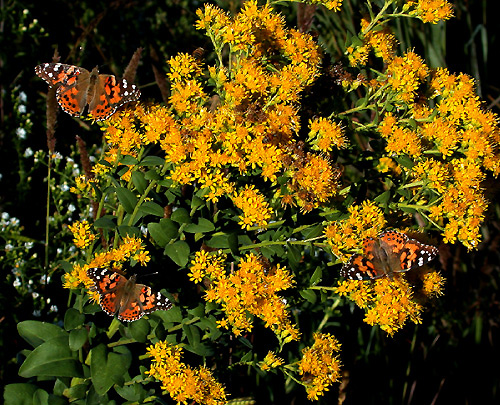Recovered from the Wayback Machine.
The RDF Poetry Finder was more than a personal interest of mine — it was an attempt to see if a project could go from idea stage to implementation through the efforts of people who participated purely on interest — no formal group formation whatsoever. Additionally, it was a project that would, I hope, bring together members from both the technical and humanities communities, in such a way that each would contribute equal expertise to the project. The type of project would force this because it really did require a deep understanding of the mechanics of technology and poetry.
The latter combination of the technologists with the community was the real interest to me. I didn’t do the Poetry Finder because I needed practice with technology — I have close to 20 years of practice, I think I get it.
Along the way, though, I made several significant mistakes. Since we learn from our mistakes, I thought I would share these:
1. Antagonizing the Tech community
I started this project out by doing a deliberate pushback against RSS and FOAF, mainly RSS. By doing this, I had hoped I could attract the attention of the people who work with RSS, particularly the RDF/RSS people, but without tying RSS into the project. In addition, I hoped I could break through a growing belief that RSS 1.0 is representative of all RDF semantic web efforts.
What I did do was antagonize the RSS 1.0 fans, and they are nothing if not loyal. This ended up losing me key technology people, as well as spinning off a lot of energy back into the RSS vortex. Not just the RSS vortex, but the ongoing personality differences that have plagued RSS for too long.
2. Not providing the right hooks for the poetry enthusiasts
I think I did better attracting people from the poetry community. However, I didn’t give them the necessary hooks in how to participate in this project.
We’ve trained the ‘user’ in the weblog community and elsewhere to be passive — the technologists will generate the idea, develop the specs, write the implementation, and help you use the technology. If you don’t implement their new technology quick enough, you’ll hear about it. If the techs aren’t moving fast enough, there’s the LazyWeb.
Well, this is good. No, I take that back. This is not good.
We’ve made the ‘user’ in our community, the weblogger or other web site owner who doesn’t have a strong technical background, into a spectator; and we’ve turned much of our technical activity into spectator sport.
Scenario: Roman arena. Two participants. The issue is RSS. Get the picture?
This was a mistake. It was one I tried to rectify with Poetry Finder, but wasn’t as effective as I needed to be. I’m not quite sure how to do this better.
3. Tied project into RDF/XML from the start
Of course, this is a technology and a specification that I’m comfortable with so it’s not surprising I would focus the project on RDF/XML. However, this triggered much of the same glazing of eyes phenomena that always occurs with RDF/XML. I did expect a little of this and hoped that not jumping into the technology right away would work around this. It did, somewhat. However by not focusing on technology from the start, I lost more of the techies.
Additionally, focusing on the use of RDF as the underlying technology from the start also brought in contention from those enthusiastic about competitive technologies, which I wasn’t expecting.
4. Not starting effort out with a prototype
I had hoped to take this project from idea to implementation in the public eye, based on public participation, but I think that the idea of a “poetry finder” is too nebulous for a unstructured group of participants. I should have started with something, no matter how light and unscalable, rather than just, “I have an idea”.
It’s too easy to shoot down “just an idea”, and too difficult to engage people behind “just an idea”. I didn’t have to provide David, but I at least needed to provide the marble.
5. Fragmented discussions
I used more than one technology to encourage group participation in Poetry Finder. Originally the technologies included this weblog and a Yahoo Discussion group, Bloggers Unlimited. There was then bleed through to emails, other discussion groups, and other weblogs.
The Bloggers Unlimited discussion descended quickly into exchanges based on RSS and FOAF, and other pure technology issues. I pulled back, trying another group, Renaissance Web, and this group has been extremely good at keeping the focus at a higher level, and avoiding too much detailed technical conversation.
A challenge with all of this communication: the discussions in the Yahoo groups, and in weblog postings and comments are good, but there is no way of tying them all together other than linking to specific messages, and through the use of Trackback. Of course, if we had something like Threadneedle, or ThreadsML, this problem would be solved because the technology would link everything together. Right?
I used to think so but after this experience, I’m not so sure. I’m finding that the connectivity between the discussion threads is not as much of a factor as the format of the threads, themselves.
For instance, I don’t think I’m the only person that got overwhelmed by trying to follow the discussions at the Yahoo group, Renaissance Web, excellent as they are. Even when sorted by thread, not date. I had a very hard time finding who said what at any given point, especially with all the embedded quoting and nesting and so on.
Trying to connect the Yahoo group discussions into the weblog was difficult because the discussion group entries have such a different style and emphasis compared to weblog posts. Weblog postings, even when focused on responding to other people, have a more persistent quality to them than discussion threads. There is a different feel to each type of discussion; trying to blend them all together in a meaningful way would be like trying to make orange juice by squeezing together six oranges and two apples. And a banana.
At least, it felt this way to me. Maybe I’m weird.
Then there is the problem of censorship in the Yahoo groups. The one and only time I deleted a message in Blogging Unlimited was a mistaken email that was sent to the group. The only time in Renaissance Web was one of my responses. However, during this time I was censored in another group — and the group was not informed that I was censored, or that this type of censorship had occured. This wasn’t directly related to the Poetry Finder, but it is a problem with Yahoo groups and even weblog comments.
Still, I liked the forum/email/discussion group because there is no ‘ownership’ of the topics, anyone could add new topics, and there was a great deal of good commentary, especially in Renaissance Web. Much more in this format than the weblogs.
However, rather than having a conversation about Poetry Finder in just my weblog, I was now having conversations in many places. This meant that I had to respond in multiple places, to multiple threads, some of which may have started out on the Poetry Finder but morphed into something else.
And how to bring all this together? How do I get the Yahoo Groups people to read my weblog entries on Poetry Finder? A link won’t necessarily do it. How do I get my weblog readers to follow the many discussion threads at Yahoo? Some people are more comfortable with email lists, some more with weblogs. How do we establish a communication across the different venues? Sure we can hack together threads between IM (Instance Messaging) and weblog and Yahoo group — but goodness, it would be like trying to hold a church service during half-time at a baseball stadium, simultaneously using a semaphore to signal the service to the blimp passing overhead, while there’s a flock of geese in the way.
And some of the geese don’t like each other.
Gah!
Within all of the many threads, I had to work at generating enthusiasm for this crazy idea in order to attract the group participation the project needed, in multiple venues. Tthis was getting exhausting, particularly in light of the pushback — not the direct pushback, which I was expecting; but the indirect pushback, the subtle and not so subtle putdowns, which I’ve not particularly adept at dealing with. The honest, intelligent, and concerned opinions from people that I’m spinning my wheels, and that his baby just ain’t gonna fly. Something else I’m not particularly adept at dealing with.
I wish I was Audrey Hepburn. She’d know what to do. And probably look good while doing it, too.
It’s not particularly easy to continue a ‘crazy, impossible, half-baked’ idea when you have a feeling that some people think you’re blowing smoke out your ass. In multiple venues.
Summary
What next.
Well, I have a tick bite, which isn’t healing. The housing complex pest specialist says the head is still in, but the infection should clear eventually. Creeps me out a bit, though — I have tiny insect chompers in my ankle. Had another thunderstorm this morning, and now it’s getting humid. My cat likes my Titanium PowerBook because she can use it for a head rest. I need to do laundry, but I’d rather take another walk. Somewhere covered in asphalt. I have some web pages and PHP I need to do for a friend. I think I’ll make chicken for dinner tonight. Better yet — BLT pizza. With beer.
Yeah: Huh?
I don’t want to abandon Poetry Finder, not the least because I don’t like people thinking that I’m ‘giving up’. Dammit, and I also think the idea has merit. But I do need to figure out how to correct my mistakes, and how to get this moving again in a constructive manner. Or, more likely, just let it die, another smoke filled idea.
In the meantime, weblogging as usual. Pics, writing, cat.




